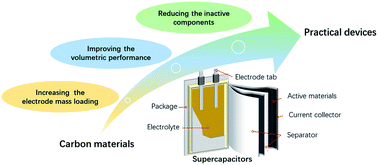Carbon materials for high mass-loading supercapacitors: filling the gap between new materials and practical applications
Abstract
The ever-increasing demands for low-cost, miniaturized, light-weight supercapacitors significantly enhance the standards of electrode materials. High capacitance and good rate performance at high mass loadings (>10 mg cm−2) are crucial for increasing the energy density of supercapacitors under the premise of high-power characteristic. However, most electrode materials show good performance only at a rather low mass loading. Increasing the electrode mass loading or thickness causes severely blocked electron and ion transport channels, decreased accessible active sites, as well as rapid fading of the capacitance and rate performance. The gap between the materials' theoretical and practical electrochemical performances drastically hinders their application. In this review, we summarize the design and preparation of high mass-loading carbon electrodes from the aspects of the entire conductive network and ion transport channels, dense structural design, and freestanding electrode construction. The basic electrochemical processes and kinetics, structure–property relationships, and new energy storage sites are discussed towards filling the gap between the new materials and practical applications. Finally, the future prospects, challenges, and promising strategies to solve the current problems are concluded to shed light on the development of high-performance practical carbon electrode materials.

- This article is part of the themed collection: Journal of Materials Chemistry A Recent Review Articles


 Please wait while we load your content...
Please wait while we load your content...